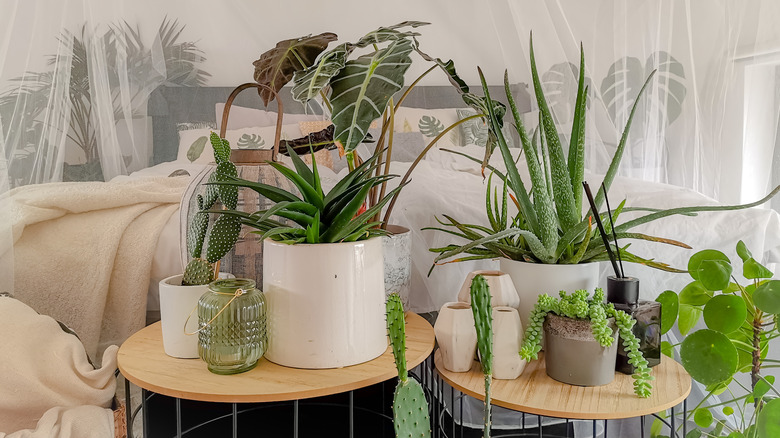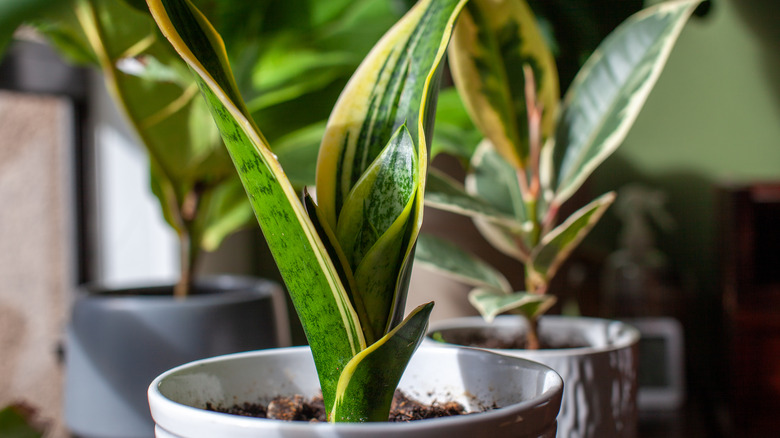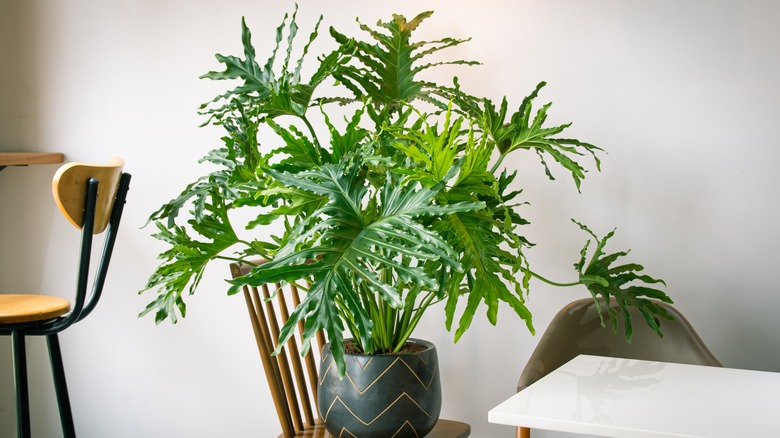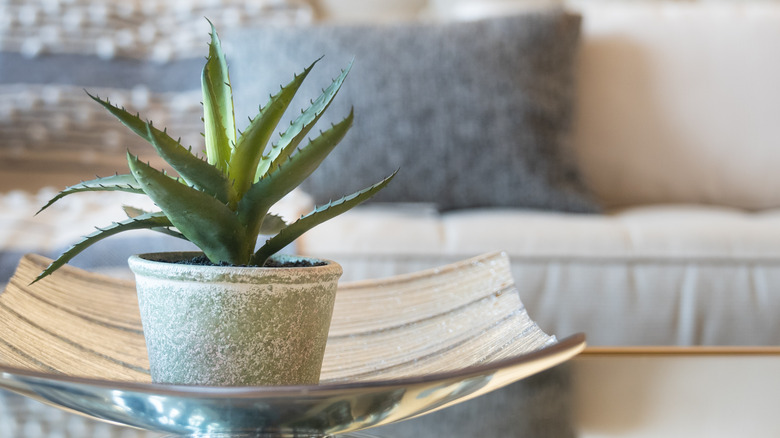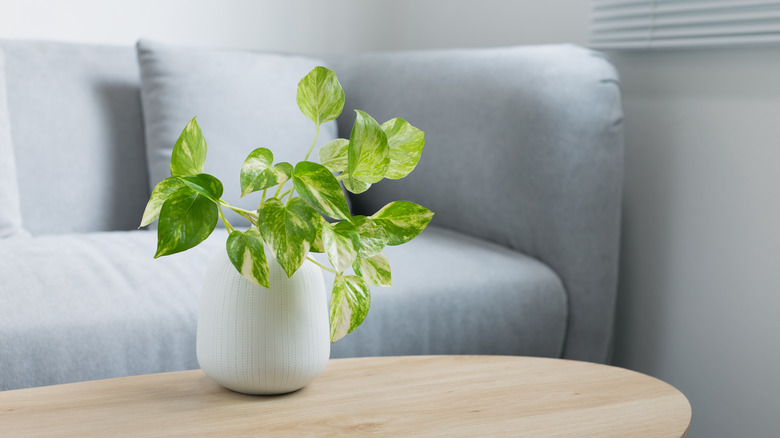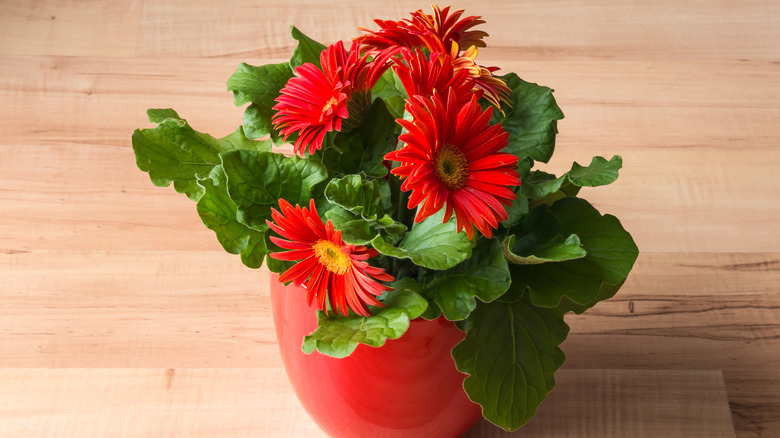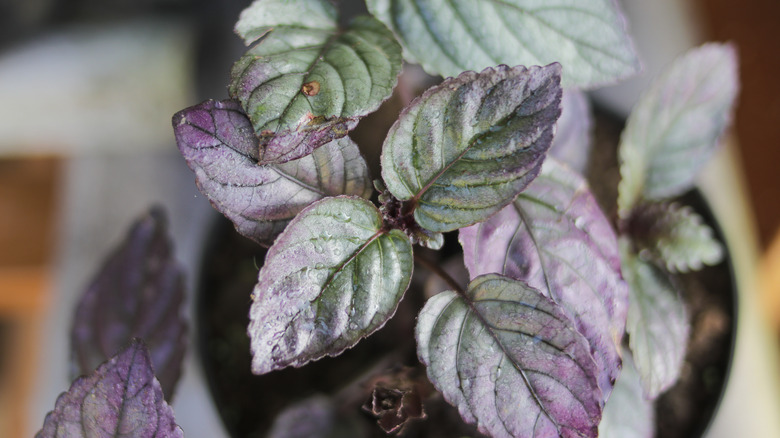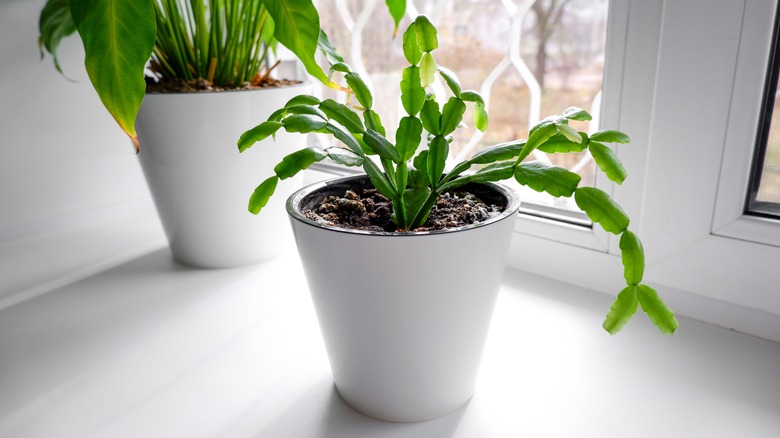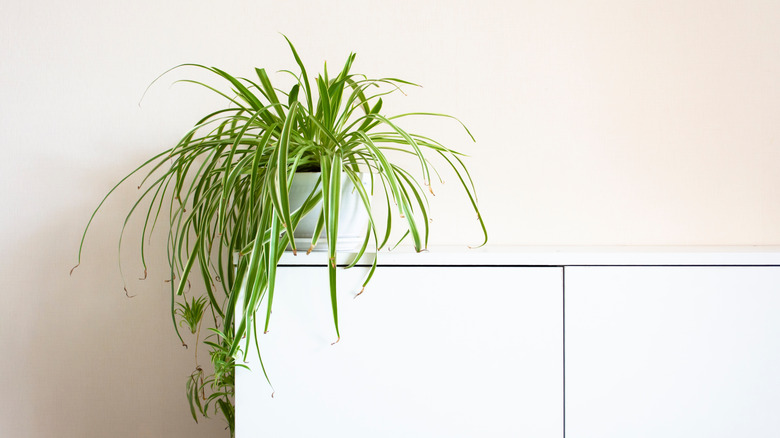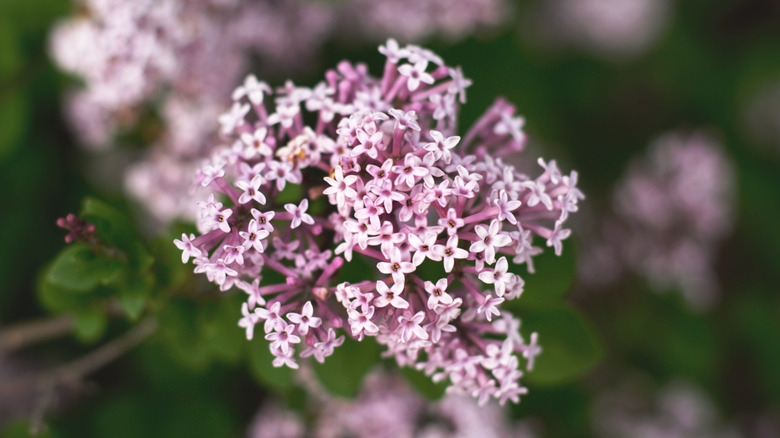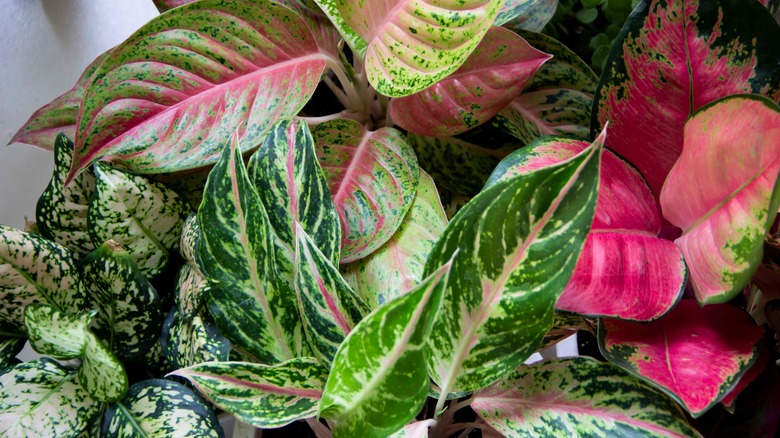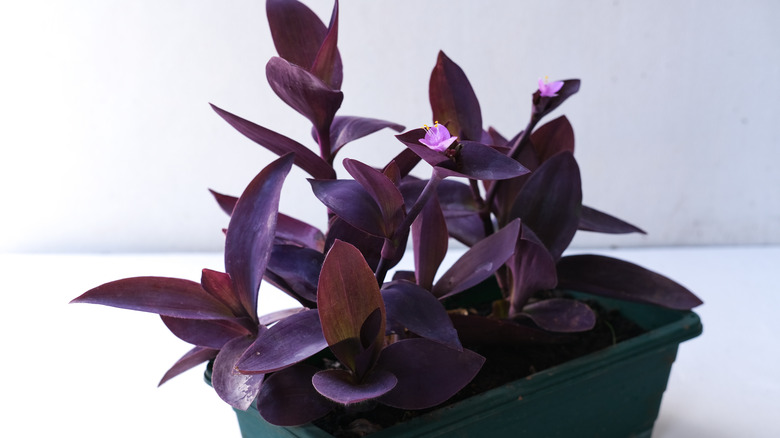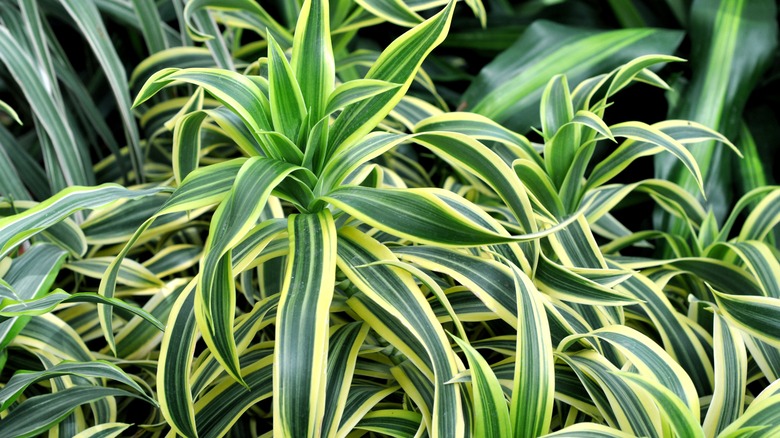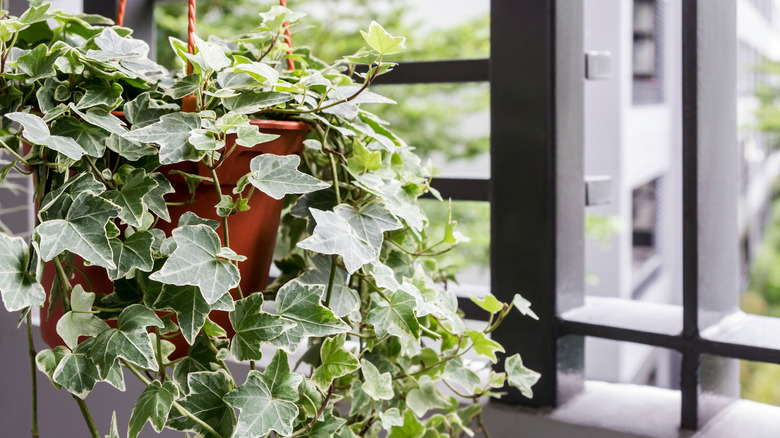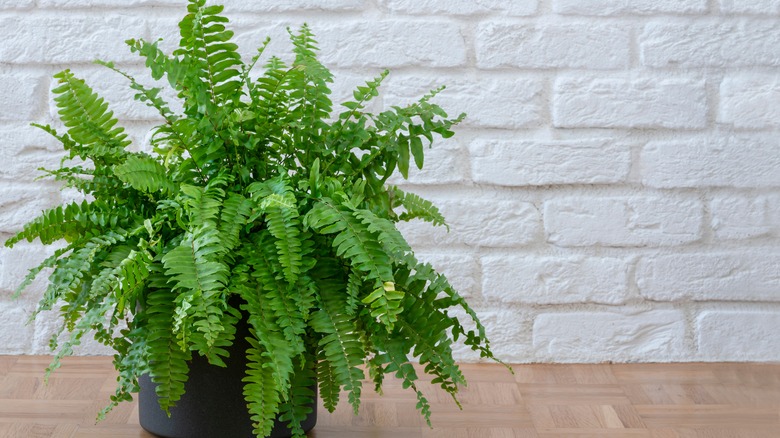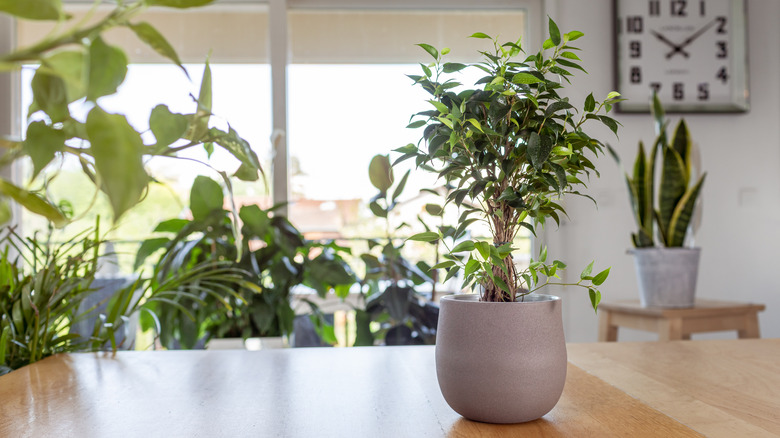The 15 Best Plants You Should Have In Your Bedroom
Since the beginning of the COVID-19 pandemic, many wholesome indoor hobbies have seen a rise in popularity, such as doing puzzles, baking bread from scratch, and crocheting. Indoor gardening has also found its way into a lot of our hearts. Not only do plants spruce up your space, but they can bring forth many advantages, including reducing stress levels, boosting your productivity, and improving the air quality in your room, as explained by Healthline. Plants such as golden pothos and gerbera daisies can filter toxins from the air, allowing you to sleep better. Others like Chinese evergreen and Christmas cacti can simply add a touch of drama to an otherwise drab corner of your bedroom.
You don't need to turn your room into a jungle to reap these benefits. Just one or two houseplants can change the way your bedroom looks and feels. All you need to do is consider your schedule and the care you can provide. Here we've compiled 15 great houseplants you should think about growing in your bedroom.
1. Snake plant
Snake plants (Sansevieria trifasciata) are extremely common houseplants known for their stiff, sword-like leaves that may be green, yellow, gray, and silver, as per Penn State Extension. People love keeping snake plants in their bedrooms because they require little maintenance, they grow slowly, and they purify the air.
Bloom Season: Spring
USDA Growing Zone: 9 to 11
Growing Conditions: Low light to bright indirect light
Soil Type: Cactus potting mix
Size: 6 inches to 3 feet tall depending on the variety
2. Split leaf philodendron
Split leaf philodendron (Philodendron bipinnatifidum) is a low-maintenance plant, though you must keep it consistently moist. Native to some parts of Paraguay and Brazil, as explained by Missouri Botanical Garden, this broadleaf evergreen is used as a houseplant in many homes worldwide.
Bloom Season: Seasonal bloomer, rarely blooms indoors
USDA Growing Zone: 9 to 11
Growing Conditions: Low to medium light
Soil Type: Moist, rich
Size: 10 to 15 feet tall, much smaller when grown indoors
3. Aloe vera
Aloe vera (Aloe vera) is an easy-to-care-for plant that is native to the warm regions of Africa, according to the University of Florida. It can be identified by its long, thick leaves that can be split open to access a gel that is used to treat burns.
Bloom Season: Early spring to late summer
USDA Growing Zone: 8 to 11
Growing Conditions: Low light to bright light
Soil Type: Well-draining potting media
Size: Up to 2 feet tall
4. Golden pothos
Golden pothos (Epipremnum aureum) is a well-known house plant for its ability to filter toxins from the air, such as formaldehyde, says The Sill. By keeping this plant in your bedroom, you can purify the air while also adding visual interest with this plant's beautiful heart-shaped leaves.
Bloom Season: Does not flower
USDA Growing Zone: 10 to 12
Growing Conditions: Low light to bright light
Soil Type: Well-draining potting mix
Size: 6 to 10 feet long when grown indoors
5. Gerbera daisies
Gerbera daisies (Gerbera jamesonii) are typically grown outdoors in the garden, but you can reap a few benefits by bringing yours inside. This plant with long-lasting flowers is great at filtering toxins from the air and releasing oxygen. Keeping your gerbera daisies in your bedroom is good for both you and the plant as container-grown gerbera is known to grow more successfully, via Clemson Cooperative Extension.
Bloom Season: Spring and early fall
USDA Growing Zone: 8 to 11
Growing Conditions: Medium to bright light
Soil Type: Rich, well-draining
Size: 6 to 18 inches tall
6. Red ivy
Red ivy (Hemigraphis Alternata) is loved for its two-toned leaves that are green-gray on top and purple underneath, as per Missouri Botanical Garden. Though it is often grown outdoors, this plant can also be nurtured indoors in containers where it will produce insignificant white flowers.
Bloom Season: Summer
USDA Growing Zone: 10 to 11
Growing Conditions: Medium to bright light
Soil Type: Moist, rich, humusy, well-draining
Size: 6 inches to 1 foot tall
7. Christmas cactus
The Christmas cactus (Schlumbergera russelliana) is named for its blooming period in the fall and winter as it reaches its greatest ornamental potential over the holidays. As said by North Carolina State Extension, this cactus produces flowers in shades of pink that are tubular with a "flower inside a flower" shape. Because Christmas cacti need specific growing conditions, they are most often grown indoors as decorative plants.
Bloom Season: Fall and winter
USDA Growing Zone: 9 to 11
Growing Conditions: Bright light
Soil Type: Moist, well-draining
Size: 6 inches to 1 foot tall
8. Spider plant
The spider plant (Chlorophytum comosum) is a wonderful houseplant because it needs very little attention, and it is a great air purifier. According to the University of Wisconsin-Madison, spider plants can filter toxins such as formaldehyde, benzene, xylene, and carbon monoxide from the air.
Bloom Season: Spring and summer
USDA Growing Zone: 9 to 11
Growing Conditions: Medium light to bright light
Soil Type: General purpose potting soil
Size: 12 to 15 inches tall
9. Valerian
Valerian (Valeriana officinalis) is often grown indoors and outdoors for its showy flowers and its health benefits. As told by Missouri Botanical Garden, its fragrant flowers, stems, leaves, and roots can all be used to create an herbal medicine known as valerian or valerian root. This medicine may be used to treat insomnia, restlessness, and anxiety.
Bloom Season: Summer
USDA Growing Zone: 4 to 7
Growing Conditions: Full sun, bright light
Soil Type: Well-draining
Size: 3 to 5 feet tall
10. Chinesse evergreen
Chinese evergreens (Aglaonemas spp.) are native to southeast Asia where they grow on the jungle floor, explains the University of Vermont Extension. They are known for their ability to survive in dim, artificial lighting indoors, which makes them great bedroom plants. Keep in mind that Chinese evergreens should not be grown near small children and pets as their leaves contain poisonous calcium oxalate crystals.
Bloom Season: Spring and summer
USDA Growing Zone: 10 to 12
Growing Conditions: Low or medium light
Soil Type: Humus-rich and well-draining
Size: 1 to 3 feet tall
11. Purple heart plant
The purple heart plant (Tradescantia pallida) is known for its small pink and purple flowers as well as its bright purple foliage, as per the University of Wisconsin-Madison. It can be grown outdoors, but it makes for a great house plant because of its compact growth and vibrant color.
Bloom Season: Mid-summer to fall
USDA Growing Zone: 7 to 10
Growing Conditions: Bright light or full sun
Soil Type: Well-draining
Size: 1 foot tall but spreads widely
12. Dracaena
Dracaena (Dracaena spp.) is a tall plant that resembles a tree with its sturdy brown stems and bushy foliage. Leaves atop dracaena plants are typically thin and green or yellow in color. Because they can only grow in consistently warm conditions, they make great bedroom plants as long as you can keep them moist, as told by Miracle-Gro.
Bloom Season: Some species produce insignificant blooms
USDA Growing Zone: 10 to 11
Growing Conditions: Bright indirect light
Soil Type: Well-draining potting mix
Size: 6 to 10 feet tall
13. English ivy
English ivy (Hedera helix) is best grown as a houseplant. When grown outdoors, it is invasive and weedy as it grows quickly and chokes out weaker plants, according to North Carolina State Extension. Keep in mind, when growing indoors, the plant cell sap from English ivy is poisonous. Contact with the sap can lead to blisters and itching.
Bloom Season: Fall and summer
USDA Growing Zone: 4 to 13
Growing Conditions: Low light to bright direct light
Soil Type: Moist, well-draining
Size: Grows up to 80 feet long outdoors, much smaller grown inside
14. Boston fern
Boston ferns (Nephrolepis exaltata 'Bostoniensis') are a difficult plant to grow but their gorgeous foliage can be very rewarding. As explained by the University of Wisconsin-Madison, this plant is ideal for growing in containers and hanging baskets indoors. They bring drama into the bedroom with arching fronds that stay green all year long.
Bloom Season: Does not flower
USDA Growing Zone: 9 to 11
Growing Conditions: Medium to bright light
Soil Type: Rich, moisture retaining, and well-drained
Size: Up to 7 feet tall
15. Weeping fig
The weeping fig (Ficus Benjamina) is a small tree perfect for growing indoors as an ornamental plant. Also known as weeping ficus, according to Clemson Cooperative Extension, this tree can be identified by its glossy leaves and thin branches. This appearance makes it a popular choice for interior decorating in bedrooms, offices, and common living spaces.
Bloom Season: Does not flower
USDA Growing Zone: 10 to 12
Growing Conditions: Bright indirect sunlight
Soil Type: Well-draining
Size: 3 to 6 feet tall
